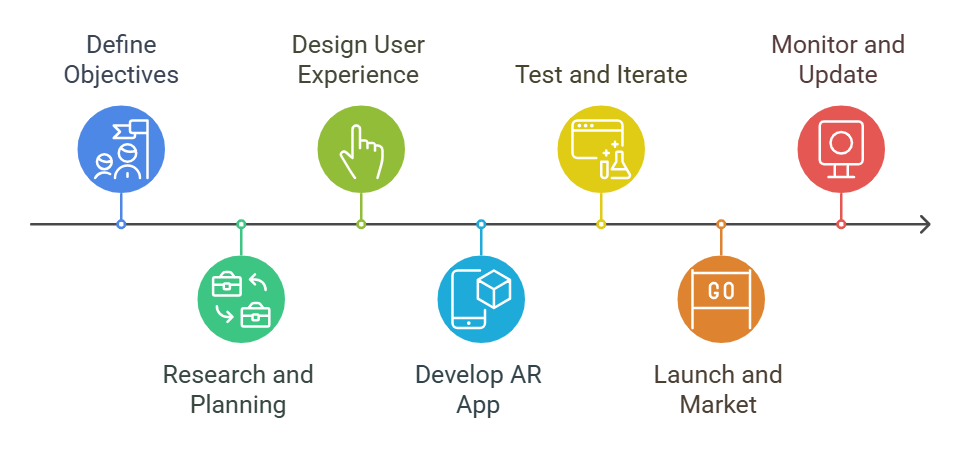Augmented reality apps transform how we interact with the world. AR augmented reality software has opened new possibilities across various industries by overlaying digital information in the real world. AR is making its mark, whether it’s enhancing shopping experiences like IKEA Place, interactive learning like Google Expeditions, or engaging entertainment like Pokemon Go. This guide will help you understand software augmented reality, the role of an AR app development company, and the essentials of AR app development.
How is Augmented Reality defined?
Augmented reality is a technology that superimposes computer-generated images, sounds, and other data onto our real-world environment. Unlike virtual reality software, which creates an entirely artificial environment, AR enhances the existing world. It can be experienced through smartphones, tablets, AR glasses, and other devices.
How Does Augmented Reality Work?
AR uses computer vision, simultaneous localization and mapping (SLAM), depth tracking, and other technologies to map the real world and overlay digital content. Here’s a simplified breakdown of how AR functions:
- Recognition: The device camera captures the real-world environment.
- Processing: AR software processes the images and identifies the objects or surfaces.
- Rendering: Digital content overlaps the real-world view, aligning with physical objects.
The Importance of Augmented Reality Software
The backbone of any AR experience is the augmented reality software that powers it. AR augmented reality software is essential for creating, deploying, and managing AR applications. It provides the tools to design digital content, integrate it with real-world elements, and ensure seamless user experiences.
Key Features of Augmented Reality Software
When choosing AR augmented reality software, consider the following features:
- Cross-Platform Support: Compatibility with different devices and operating systems.
- User-Friendly Interface: Intuitive tools that simplify the development process.
- Real-Time Tracking: Ability to accurately track and respond to user movements.
- Integration Capabilities: Easy integration with other systems and applications.
- Scalability: Support for future updates and expansions.
Choosing an Augmented Reality App Development Company
Working with an augmented reality app development company can be crucial to your project’s success. These companies specialize in creating AR experiences and can provide the expertise needed to bring your vision to life.
Factors to Consider
When selecting an AR app development company, keep these factors in mind:
- Experience and Expertise: Look for companies with a proven track record in AR app development.
- Portfolio: Examine their previous projects to evaluate their skills and creativity.
- Technology Stack: Ensure they use the latest AR technologies and tools.
- Client Testimonials: Read reviews and testimonials to gauge client satisfaction.
- Communication: Choose a company that communicates effectively and understands your goals.
Steps in Augmented Reality App Development

Developing an AR app involves several stages, from ideation to deployment. Here’s a step-by-step guide:
1. Define Your Objectives
Before starting the development process, clearly define what you want to achieve with your AR app. Identify your target audience, the problem you’re solving, and the features your app will include.
2. Research and Planning
Conduct thorough research to understand the market, competitors, and current AR trends. Create a detailed plan outlining the app’s functionality, design, and development timeline.
3. Design the User Experience
Design plays a crucial role in AR apps. Focus on creating an intuitive and engaging user experience. Consider the spatial interactions and how users interact with digital content in the real world.
4. Develop the AR App
Start the development process by choosing the right AR platform and tools. Collaborate with your development team to build the app and integrate the necessary features and functionalities.
- AR Platforms: Popular platforms include ARKit (for iOS), ARCore (for Android), and Unity.
- Development Tools: Use Vuforia, Wikitude, and MaxST for efficient AR development.
5. Test and Iterate
Testing is important to make sure the app functions smoothly. Conduct thorough testing in different environments and devices. Gather user feedback and make necessary improvements.
6. Launch and Market the App
Once testing is complete, launch the app on the appropriate app stores. Implement a marketing strategy to promote your AR app and reach your target audience.
7. Monitor and Update
After launch, continue to monitor the app’s performance and user feedback. Regularly update the app to fix bugs, add new features, and enhance user experience.
Benefits of Augmented Reality App Development
Developing an AR app offers numerous benefits:
- Enhanced User Engagement: AR provides immersive experiences that captivate users and increase engagement.
- Competitive Advantage: Stay ahead of competitors by providing innovative AR solutions.
- Increased Brand Awareness: Unique AR experiences can boost brand visibility and recognition.
- Improved Learning and Training: AR can simplify complex concepts and improve learning outcomes.
- Boosted Sales: AR can enhance shopping experiences, increasing sales and customer satisfaction.
Conclusion
Augmented reality app development is a powerful way to create engaging and interactive experiences. By understanding the role of augmented reality software, choosing the right development company, and following the development process, you can successfully launch an AR app that meets your objectives and delights users.
As software augmented reality technology continues to evolve, the possibilities for innovation are endless. Embrace AR augmented reality software to transform your ideas into reality and stay ahead in the competitive digital landscape.







